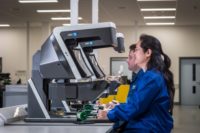REDMOND, WA — Radiant Vision Systems will present methods for in-vehicle display testing at the Automotive Visual and Display Technologies USA event taking place March 26-28 at the Sheraton Hotel in Ann Arbor, MI.
Radiant Automotive Business Leader Matt Scholz will present approaches to improving display design and quality control in “New Measurement Methods to Solve Emerging Display Test Challenges,” scheduled from 3:20-4:00 p.m. on the first day of the conference, March 26.
The evolution of automotive manufacturing has diversified the scope and role of displays in the vehicle. Displays come in a variety of shapes and sizes; appearing in mirrors, encompassing the entire dashboard, as free-form OLED and LCD technologies, and as head-up displays (HUDs) in the windshield. These integrations introduce new considerations for quality testing to ensure adequate display performance in design and production. Non-rectangular displays undergo new mechanical stresses that can introduce unforeseen defects, or defects in areas not previously observed in standard flat panel displays (FPDs). These defects include new manifestations of dead pixels and line defects, or mura (blemishes) in new locations on the display. Additionally, as displays are integrated at larger scale and within all areas of the vehicle, new view angles and ambient light conditions have a much greater impact on display visibility. As these challenges emerge, display test methods must be refined to evaluate a broader range of display characteristics.
“There are a growing number of concerns when it comes to evaluating automotive display quality,” said Scholz. “Displays represent a much larger portion of the real estate within today’s vehicles, and therefore have a much more significant impact on vehicle operation and brand perception if imperfections are evident. To ensure quality, display test systems must accommodate new display sizes and shapes; meaning more comprehensive spatial measurement capability. For each new display technology or feature, a specific measurement method must be defined. At Radiant, we have taken our photometric measurement systems to the lab to characterize new display types and standardize test methods to address emerging challenges. We now have methods for characterizing and correcting view-angle-dependent uniformity of OLED displays, quantifying the effect of sparkle (caused by anti-glare layers) on display quality, and capturing complete photometric and dimensional measurements required for HUD evaluation.”
For information or to register for Automotive Visual and Display Technologies USA, visit automotive-display-usa.iqpc.de.



